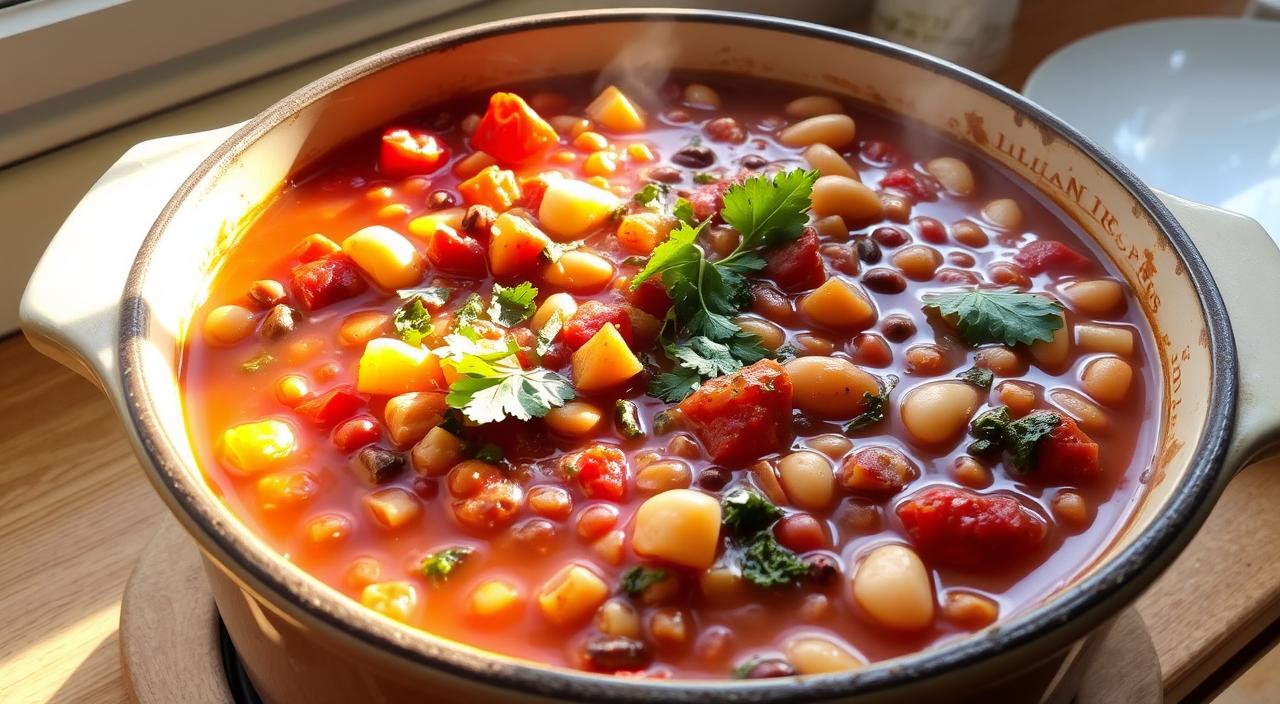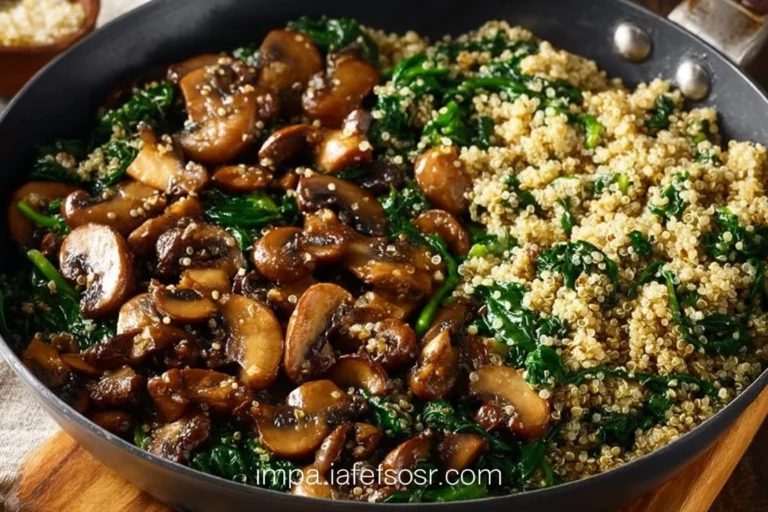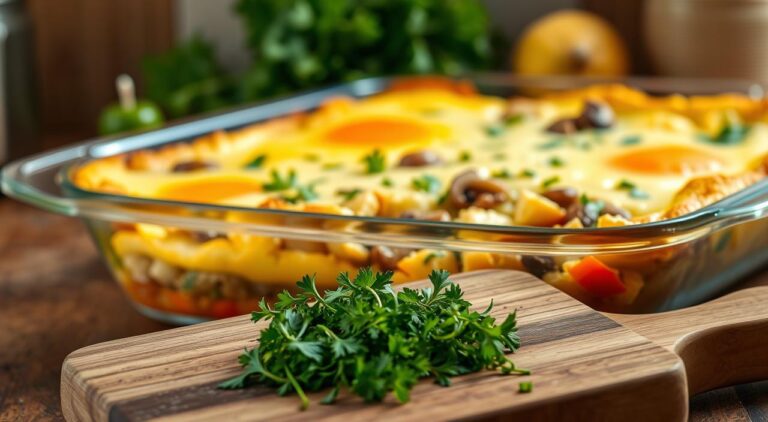Delicious Minestrone Casserole: A Hearty One-Pot Meal
Ever wanted the taste of Italian soup but something more for dinner? Our Minestrone Casserole is the answer. It’s a mix of Italian soup and a baked dish, great for family meals or weeknights.
This hearty one-pot meal has veggies, beans, and pasta in a tasty tomato broth. Unlike soup, it’s easy to serve in slices.
This dish is special because it’s easy to make and healthy. It’s full of protein, fiber, and vitamins. You can also change it up with what’s in season or what you have at home.
We’ll show you how to make this comforting dish from start to finish. We’ll cover picking ingredients to serving tips, so your hearty casserole recipe is perfect every time.
Key Takeaways
- Transform traditional minestrone soup into a sliceable, satisfying casserole
- Create a complete one-pot meal that’s perfect for family dinners
- Enjoy the nutritional benefits of vegetables, beans, and whole grains
- Save time with make-ahead options that improve with flavor overnight
- Customize the recipe based on seasonal ingredients or dietary preferences
- Serve as a standalone meal or pair with crusty bread for a complete dinner
The Origins and Appeal of Minestrone Casserole
Minestrone casserole is a perfect example of cultural adaptation. It turns an old Italian soup into a hearty dish for today’s families. This change is not just about how it’s served. It’s a thoughtful way to meet our modern eating needs.
The shift from soup to casserole shows how classic recipes can evolve while staying true to their roots.
From Traditional Italian Soup to Baked Casserole
Minestrone soup has been a key part of Italian food for centuries. It dates back to ancient Rome. The name “minestrone” comes from “minestra,” meaning “soup” in Italian.
It was originally a way to use up seasonal veggies and avoid food waste.
Home cooks turned it into a casserole to make it more filling. By baking it, they added crispy edges and melted cheese. This made the soup into a new, yet familiar dish.
The casserole version also brings out stronger flavors. Ingredients blend together during baking. What was once a starter or side dish now becomes a full meal, packed with nutrients.
Why This Dish Is Perfect for American Families
American families face many challenges at mealtime. Minestrone casserole is a great solution. It’s easy to make and clean up, perfect for busy homes.
It’s also a family-friendly dinner idea that meets many nutritional needs. It’s a single dish that can please everyone.
The dish is also great for families with picky eaters or dietary restrictions. It’s easy to add veggies, which kids might not mind eating.
Moreover, it’s great for meal planning. Families can make it on weekends and enjoy it all week. Or, they can freeze it for later.
| Feature | Traditional Minestrone Soup | Minestrone Casserole | Benefit to Families |
|---|---|---|---|
| Texture | Broth-based, soupy | Hearty, layered, with crispy elements | More satisfying as a main dish |
| Serving Style | Requires bowls and spoons | Can be plated and eaten with fork | Easier for young children to eat |
| Meal Planning | Best served fresh | Excellent for meal prep and freezing | Saves time on busy weeknights |
| Nutritional Density | Lighter meal option | Complete one-pot nutrition | Fewer side dishes needed |
Essential Ingredients for a Flavorful Minestrone Casserole
Creating a tasty minestrone casserole starts with a mix of colorful veggies, proteins, and spices. This dish is great because you can use what you have. We’ll show you the key parts that make it a healthy dinner idea everyone will love.
Fresh Vegetables to Include
The heart of a minestrone casserole is the Italian soffritto. It’s a mix of onions, carrots, and celery that sets the flavor. This mix is the base of all the delicious layers.
Next, add seasonal veggies for color, texture, and nutrition. Zucchini and yellow squash are tender. Sweet potatoes add heartiness and sweetness.
Leafy greens like kale, Swiss chard, or spinach boost nutrition and color. Harder veggies like carrots and sweet potatoes go in early. Delicate greens like kale go in last to stay fresh.
Protein Options and Alternatives
Beans are the main protein in a vegetarian casserole recipe like minestrone. Cannellini beans are creamy and mild, soaking up flavors well.
For variety, try kidney beans for a heartier taste or chickpeas for a nutty flavor. Lentils are a quick-cooking, plant-based option that works great.
If you’re not vegetarian, you can add proteins like Italian sausage, ground turkey, or pancetta. They complement the veggies well.
| Protein Option | Preparation Method | Flavor Profile | Cooking Time |
|---|---|---|---|
| Italian Sausage | Brown before adding vegetables | Savory with fennel notes | 5-7 minutes |
| Ground Turkey | Brown with olive oil and garlic | Mild, takes on surrounding flavors | 7-10 minutes |
| Pancetta | Crisp in pan before adding vegetables | Rich, salty depth | 3-5 minutes |
| Shredded Chicken | Add pre-cooked | Neutral, adapts to seasonings | Already cooked |
Herbs, Spices, and Seasonings
The flavor of minestrone casserole comes from herbs and spices. Dried oregano, basil, and thyme are the classic Italian mix. They give the dish its unique taste.
Fresh garlic is a must – use at least 3-4 cloves, minced. Bay leaves add subtle depth, and red pepper flakes add a gentle heat.
For more flavor, try these flavor-enhancing additions:
- Parmesan rind: Simmer for deep flavor
- Tomato paste: A tablespoon adds richness
- Quality broth: Carries flavor throughout
- Fresh herbs as garnish: Basil, parsley, or rosemary
Pay attention to the liquid – use low-sodium broth. This lets you control the salt and balance the flavors perfectly.
Kitchen Equipment and Setup
Before you start making your minestrone casserole, make sure your kitchen is ready. This hearty one-pot meal needs the right tools to get the flavors and textures just right. Let’s look at the key equipment that will make your casserole delicious and easy to clean up.
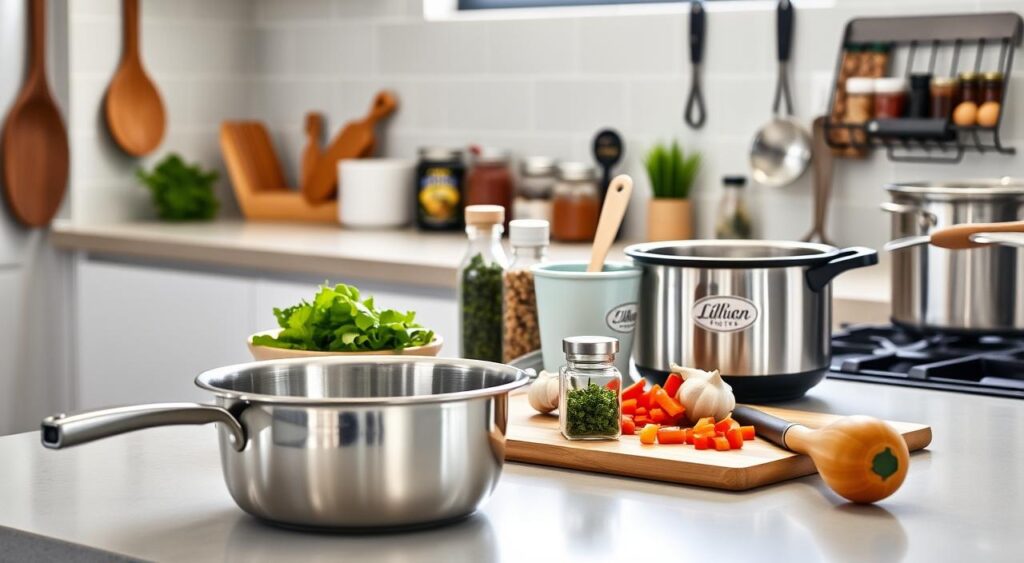
Choosing the Right Casserole Dish
The right dish is key for a great minestrone casserole. Choose a dish that’s 9×13 inches and 3-4 quarts. This size is perfect for 4-6 people.
You have many good options for materials:
- Ceramic casserole dishes heat evenly and keep food warm longer.
- Glass baking dishes let you see how your food is cooking and don’t absorb flavors.
- Enameled cast iron is great for one-pot meals because it retains heat well.
Make sure your dish is at least 2-3 inches deep. This way, all your ingredients fit without spilling over.
Other Helpful Tools and Appliances
There are more tools to help you make your minestrone casserole:
- A sharp chef’s knife and sturdy cutting board for chopping veggies
- A wooden spoon or heat-resistant spatula for cooking and mixing
- Measuring cups and spoons for accurate amounts
- A Dutch oven for both sautéing and baking
For quick weeknights, a food processor can cut down prep time. A good ladle and spoon are also useful for serving.
With these tools, making minestrone casserole is easy. It’s a great easy weeknight meal that’s quick to set up and clean up, but full of flavor.
Preparing Your Vegetables and Ingredients
The secret to a great minestrone casserole is in how you prep your veggies and ingredients. Doing it right means even cooking, the right texture, and flavors that blend well. This makes a simple mix of ingredients into a healthy dinner idea that everyone loves.
Cutting and Chopping Techniques
Chopping veggies the same size is key for even cooking. Cut carrots, celery, and potatoes into ½-inch cubes. This way, they all cook tender at the same time.
Each veggie needs a different cut for your casserole. Cut dense veggies like carrots and potatoes smaller than quick-cooking ones like zucchini. Onions should be finely diced to blend in, while bell peppers add color and texture.
For leafy greens like spinach or kale, remove stems and tear or chop leaves. They cook down a lot, so start with bigger pieces in your minestrone casserole.
Time-Saving Preparation Methods
Make this recipe an easy weeknight meal by prepping veggies ahead. Chop carrots, celery, and onions up to three days before and store them in airtight containers.
Use smart shortcuts when you’re short on time. Use pre-minced garlic, frozen diced onions, and canned beans (rinsed well) to save time. Pre-washed greens also save you a step.
Make your own freezer prep kits by chopping veggies in bulk. Portion them out and freeze them in zip-top bags. Label each bag with what’s inside and when, for easy access later.
For ultimate convenience, prep multiple casseroles at once. Assemble them up to the baking stage, then freeze for easy meals later.
Step-by-Step Minestrone Casserole Recipe
Minestrone casserole is made in four stages, each adding flavor. It’s a heartier version of traditional soup, perfect for family dinners. We’ll show you how to make it every time.
Creating the Flavorful Base
Start by heating 3 tablespoons of olive oil in a large Dutch oven over medium heat. Add one diced onion, two chopped carrots, and two diced celery stalks. Cook these for 5-7 minutes until they soften and smell great.
Next, add 3-4 minced garlic cloves and cook for just 30 seconds. Don’t let the garlic brown, as it can make the dish bitter. This base adds rich, savory flavors to the casserole.
For more depth, add a tablespoon of tomato paste and cook for 1-2 minutes. This simple step adds a lot of umami flavor to your casserole.
Adding Liquids and Seasonings
Pour in 4 cups of vegetable or chicken broth and one 14-ounce can of diced tomatoes with their juices. The broth and tomatoes should be in a 4:1 ratio. Bring it to a gentle simmer.
Now, add herbs and seasonings. Use 1 teaspoon dried oregano, 1 teaspoon dried basil (or 2 tablespoons fresh, chopped), 1 bay leaf, and ½ teaspoon each of salt and pepper. Timing matters—dried herbs should be added early, while fresh herbs work better added later.
Taste and adjust the seasonings as needed. Remember, the flavors will concentrate during baking, so it’s better to slightly under-season now and adjust after baking if necessary.
Incorporating Proteins and Starches
Add one 15-ounce can each of drained kidney beans and cannellini beans. These provide protein and create a hearty texture. For meat lovers, brown 8 ounces of Italian sausage or ground beef separately and add it now.
For pasta, use 1 cup of small shapes like ditalini, orzo, or small shells. Pre-cook the pasta to just under al dente (about 2 minutes less than package directions) before adding it to the mixture. This prevents the pasta from becoming mushy during baking.
Stir in 2 cups of chopped seasonal vegetables like zucchini, green beans, or bell peppers. These add color, nutrition, and textural contrast to your hearty casserole recipe.
Baking to Perfect Consistency
Preheat your oven to 375°F (190°C). If your cooking vessel isn’t oven-safe, transfer the mixture to a 9×13 casserole dish. Top with 1 cup of shredded Parmesan or mozzarella cheese for a golden, bubbly crust.
Bake uncovered for 25-30 minutes until the top is golden brown and the edges are bubbling. The casserole is done when a spoon inserted into the center comes out hot and the pasta is fully tender.
Allow your minestrone casserole to rest for 10-15 minutes before serving. This crucial resting period allows the starches to set and thicken the casserole to the perfect spoonable consistency. The finished dish should hold its shape when served but remain moist and flavorful.
Customizing Your Minestrone Casserole
Minestrone casserole is a canvas for creativity. It can change with the seasons, dietary needs, and local flavors. This makes it a hit in American kitchens all year. You can use summer’s fresh veggies or winter’s hearty ones, meet special diets, or add local touches. Your minestrone casserole can grow while keeping its comforting feel.
Seasonal Vegetable Variations
Adapting minestrone casserole to the season is a joy. In spring, add asparagus, sweet peas, and baby spinach for a bright taste. Summer brings juicy tomatoes, colorful peppers, and zucchini for a lively casserole.
Fall’s minestrone has butternut squash, kale, and mushrooms for depth. Winter’s version includes cabbage, carrots, and turnips that cook well slowly. These changes boost flavor and save money by using what’s in season.
Dietary Adaptations: Vegetarian, Vegan, and Gluten-Free
Minestrone casserole works for many diets without losing flavor. For vegetarian casserole recipes, use vegetable broth and beans or lentils for protein. Nutritional yeast or hard cheese can add depth if you can have dairy.
Vegan options use cashew cream or dairy-free pesto for richness. For gluten-free, try rice, quinoa, or gluten-free pasta. Always check your broth and seasonings are gluten-free to avoid hidden wheat.
Regional American Twists on the Italian Classic
Across America, cooks have made their own versions of this Italian-inspired dish. In the Southwest, it gets spicy with green chilies, corn, and black beans, topped with avocado and lime. Southern versions add okra, collard greens, and smoky bacon for a unique taste.
| Region | Key Ingredients | Signature Flavors | Typical Toppings |
|---|---|---|---|
| New England | White beans, potatoes, carrots | Thyme, bay leaf | Oyster crackers, parsley |
| Southwest | Black beans, corn, chilies | Cumin, oregano | Avocado, lime, cilantro |
| Pacific Northwest | Mushrooms, kale, hazelnuts | Rosemary, garlic | Hazelnut oil, local cheese |
| Southern | Okra, collards, sweet potato | Smoked paprika, sage | Cornbread crumbles, hot sauce |
Serving Suggestions and Perfect Pairings
Make your minestrone casserole even better by adding sides and drinks that match its flavors. A well-thought-out meal turns this comfort food recipe into a special occasion. Minestrone’s strong taste is balanced by lighter sides that offer a nice contrast.
Complementary Side Dishes
A fresh green salad with a simple vinaigrette is a great match for the casserole. Try a Caesar salad or an arugula salad with lemon dressing to balance the richness.
For bigger family-friendly dinner ideas, roasted veggies are perfect. In spring, grilled asparagus with olive oil is a hit. In fall and winter, roasted Brussels sprouts or honey-glazed carrots add variety and texture.
Even the pickiest eaters will love simple sides like garlic green beans or a caprese salad. These sides not only add to your comfort food recipe but also sneak in more veggies.
Bread, Wine, and Beverage Recommendations
No Italian meal is complete without bread. A crusty Italian loaf or warm focaccia is perfect for dipping in the casserole’s sauce. Garlic bread or herbed breadsticks are also great for all ages.
For adult gatherings, wine pairings can make your family-friendly dinner ideas more sophisticated. Medium-bodied Italian reds go well with the tomato-based casserole. There are also non-alcoholic options for everyone to enjoy.
| Beverage Type | Specific Recommendation | Why It Works | Serving Suggestion |
|---|---|---|---|
| Red Wine | Chianti or Montepulciano | Balances acidity in tomato base | Serve slightly below room temperature |
| White Wine | Pinot Grigio | Lighter option for vegetable-heavy versions | Chilled but not ice cold |
| Non-Alcoholic | Sparkling water with lemon | Refreshing palate cleanser | Serve with plenty of ice |
| Family-Friendly | Italian sodas or herb-infused iced tea | Sweet contrast to savory casserole | In colorful glasses with fun garnishes |
These pairings turn your minestrone casserole into a full meal for any occasion. The right sides and drinks bring out the comfort food recipe’s charm, making it a meal everyone will love.
Meal Planning with Minestrone Casserole
Planning meals with minestrone casserole can make weeknights easier. It’s a great mix of nutrition, taste, and convenience for busy families. This dish helps save time, lowers stress, and ensures tasty, healthy meals.
Incorporating into Weekly Meal Prep
To make minestrone casserole a weekly staple, plan ahead. Spend an hour on Sunday chopping veggies, cooking beans, and making the sauce. Store these in airtight containers until you’re ready to put it all together.
For easy weeknight meals, bake the casserole partway ahead. Bake it until it’s almost done, then chill it. Finish baking for 20-25 minutes while you prep a simple salad.
Batch cooking is another smart move. Double the recipe and portion it out for lunches or dinners. A big casserole can yield eight servings, covering several meals. This turns a complex recipe into a convenient, healthy dinner option.
Budget-Friendly Shopping Tips
To make minestrone casserole affordable, shop smart. Choose seasonal veggies for better taste and savings. In summer, pick fresh zucchini, tomatoes, and bell peppers. In winter, go for carrots, potatoes, and squash.
Use frozen veggies like spinach, peas, and green beans for nutrition and savings. Canned tomatoes and beans are also cost-effective. They offer great value for this dish.
Stock a basic Italian pantry with herbs, pasta, and canned tomatoes. This lets you whip up minestrone casseroles anytime. Keep an eye out for sales to stock up on these items.
| Cost-Saving Strategy | Potential Savings | Impact on Recipe | Best For |
|---|---|---|---|
| Seasonal Shopping | 30-50% | Enhanced flavor | Fresh vegetables |
| Frozen Alternatives | 20-40% | Consistent quality | Off-season ingredients |
| Bulk Cooking | 25-35% | Time efficiency | Weekly meal planning |
| Pantry Staples | 15-25% | Convenience | Last-minute meals |
Use veggie scraps for homemade broth. Turn stale bread into croutons. Use leftover casserole for new meals. These tips make minestrone casserole both tasty and budget-friendly.
Storing, Freezing, and Reheating Tips
Learn how to keep your minestrone casserole fresh for longer. Our tips will help you store, freeze, and reheat this one-pot meal. This way, you can enjoy it multiple times, saving time and effort.
Proper Storage Guidelines
Let your minestrone casserole cool down before putting it in airtight containers. This stops it from getting soggy. It stays fresh in the fridge for 3-4 days.
Freezing is best for longer storage. Divide it into portions for easy thawing. If it has pasta, cook it a bit less so it softens when reheated.
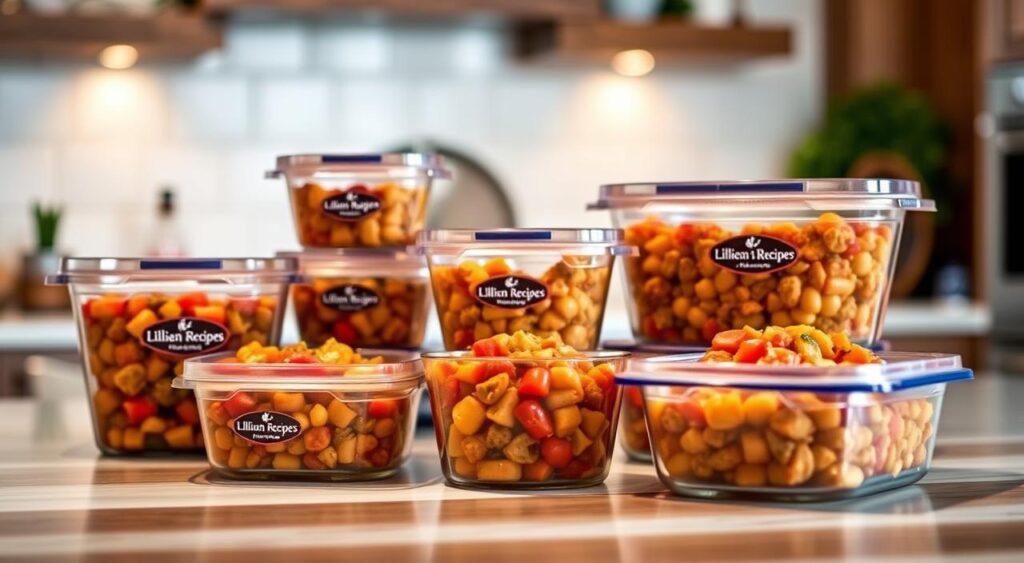
Mark containers with the date and what’s inside. Use them within 2-3 months for the best taste. For soups and stews, freeze them in containers with little to avoid freezer burn. Freeze without pasta or soft veggies, then add them when reheating.
Reheating Methods for Best Flavor and Texture
The oven is the best for reheating your casserole. Heat it to 350°F, cover it with foil, and warm for 20-30 minutes. Remove the foil for a crispy top in the last 5 minutes.
For quick reheating, use the microwave for single servings. Cover it loosely and heat in 1-minute bursts, stirring between each.
Stovetop reheating is great for frozen portions. Add a bit of broth or water and heat it gently. This keeps the veggies’ texture.
Adding fresh herbs or Parmesan before serving will make your one-pot meal taste like new. It’s a great way to refresh the flavors.
Troubleshooting Common Issues
Getting the perfect minestrone casserole can be tricky. Even with the best recipes, things like fresh ingredients, oven temperature, and cookware can change your dish. Let’s look at how to fix common problems with your hearty casserole recipes.
Fixing Texture Problems
One big issue is too much liquid, making it soupy instead of sliceable. If it’s too wet, try baking without the lid for 15-20 minutes. You can also add a bit of tomato paste or breadcrumbs to soak up the extra water.
If it’s too dry, add a little broth (start with ¼ cup) and bake for a few minutes. But be careful not to make it too soggy.
Vegetables that cook unevenly can be a problem. Cut them all to the same size for even cooking. For hard veggies like carrots and potatoes, cook them a bit before adding to the casserole. If pasta gets mushy, add it later or use a type that stays firm.
Adjusting Flavors and Seasonings
If your casserole tastes bland, don’t worry! Add a Parmesan rind during cooking (remove before serving) or a splash of balsamic vinegar. A teaspoon of bouillon paste can also add a lot of flavor.
Too acidic? Add a bit of sugar or baking soda. For too much salt, use a raw potato to soak up the salt, then remove it. You can also dilute it with unsalted broth and veggies.
| Common Issue | Possible Cause | Quick Solution | Prevention Tip |
|---|---|---|---|
| Too watery | Excess liquid, undercooked | Uncover and extend cooking time | Pre-cook high-moisture vegetables |
| Too dry | Overbaking, insufficient liquid | Add broth in small increments | Check doneness 10 minutes early |
| Bland flavor | Underseasoning, lack of aromatics | Add herbs, acid, or umami boosters | Season in layers while cooking |
| Mushy pasta | Overcooked, wrong pasta type | Add fresh al dente pasta when serving | Use short, sturdy pasta shapes |
Want that real Italian taste? Add fresh herbs in the last 10 minutes. A drizzle of olive oil before serving can also make it better. Remember, flavors get better with time, so it might taste even better the next day!
Conclusion: Enjoying Your Homemade One-Pot Wonder
Our minestrone casserole guide ends with the best part: enjoying it with loved ones. This dish is a mix of nutrition and comfort in every bite. It’s a transformed Italian classic.
What makes minestrone casserole special is its flexibility. You can make many versions based on what’s in season or your family likes. The basic recipe stays the same, but you can make it your own.
This dish connects old-world cooking with today’s needs for easy meals. It has the slow-cooked flavors of traditional minestrone. Plus, it’s a casserole that’s easy to slice, store, and reheat.
Cooking should be fun! If your first try isn’t perfect, keep trying. Each time, you’ll get better at finding the right textures and flavors. The techniques we shared are a good start, but your own touch will make it special.
Minestrone casserole is great for any meal, from weeknights to meal prep. It’s full of veggies, has a satisfying texture, and warms your heart. It’s all about what we love in home cooking.
We hope this guide makes you want to cook this nutritious, flexible dish. Happy cooking!
FAQ
Can I make minestrone casserole ahead of time?
Yes, you can make minestrone casserole ahead of time. It’s great for make-ahead meals. You can refrigerate it for 3-4 days or freeze it for 2-3 months.
Let it cool completely before storing. Wrap it well to prevent freezer burn. When you’re ready to serve, reheat it in a 350°F oven for 25-30 minutes if refrigerated, or 45-60 minutes if frozen after thawing.
What pasta works best in minestrone casserole?
Small, sturdy pasta shapes are best for minestrone casserole. Try ditalini, small shells, elbow macaroni, or orzo. These shapes stay firm during baking.
Undercook the pasta slightly before adding it to your casserole. It will cook more during baking.
How can I make this recipe vegetarian or vegan?
To make this recipe vegetarian, use vegetable broth instead of chicken or beef broth. For a vegan version, omit cheese toppings and use vegan cheese alternatives. Add extra beans or lentils for protein.
For depth of flavor without animal products, add soy sauce, miso paste, or more herbs and spices.
My casserole turned out too watery. How can I fix it?
If your casserole is too watery, there are a few solutions. For an already-baked casserole, bake it uncovered to evaporate excess liquid.
For future batches, drain canned beans and tomatoes well. Use less broth initially. Add tomato paste to thicken the sauce. Sprinkle in small pasta or quick-cooking grains to absorb excess liquid.
Can I use frozen vegetables in my minestrone casserole?
Yes, you can use frozen vegetables in minestrone casserole. Try frozen mixed vegetables, peas, green beans, or corn. Add them without thawing first.
Be aware they may release more moisture. You might need to reduce the broth slightly. Thaw and squeeze dry frozen leafy greens like spinach before adding.
How do I know when my minestrone casserole is done baking?
Your casserole is done when it’s bubbling around the edges and the top is golden brown. The vegetables should be tender when pierced with a fork. The internal temperature should be about 165°F.
Typically, this takes 25-30 minutes in a 375°F oven. If the top browns too quickly, cover loosely with foil for the remaining time.
What’s the best way to serve minestrone casserole for a crowd?
For a crowd, bake the casserole in a large, attractive dish. Let it rest for 10-15 minutes before serving. Serve with a sturdy spoon and spatula.
Offer crusty bread, a simple green salad, and roasted vegetables for a complete meal. For buffet service, make individual ramekins for guests to take.
Can I add meat to this vegetarian casserole recipe?
Yes, you can add meat to this recipe. Brown Italian sausage, ground beef, or ground turkey before adding vegetables. Cooked chicken, turkey, or ham can be added with the beans.
For a flavor boost without much meat, add diced pancetta or bacon to the initial sauté. Use chicken broth instead of vegetable broth for more flavor.
How can I make this recipe gluten-free?
To make gluten-free minestrone casserole, use gluten-free pasta, rice, or quinoa. Undercook gluten-free pasta as it can become mushy quickly.
Verify that your broth, canned beans, and seasonings are gluten-free. Use cornstarch or a gluten-free flour blend for thickening instead of wheat flour.
What’s the best way to reheat leftover minestrone casserole?
Reheat minestrone casserole in a 350°F oven, covered with foil, for 15-20 minutes. This method keeps the casserole’s texture. For single servings, microwave on medium power with a damp paper towel over the top.
If it seems dry, add a tablespoon or two of broth or water. Finish with fresh herbs or grated cheese to refresh the flavors.

